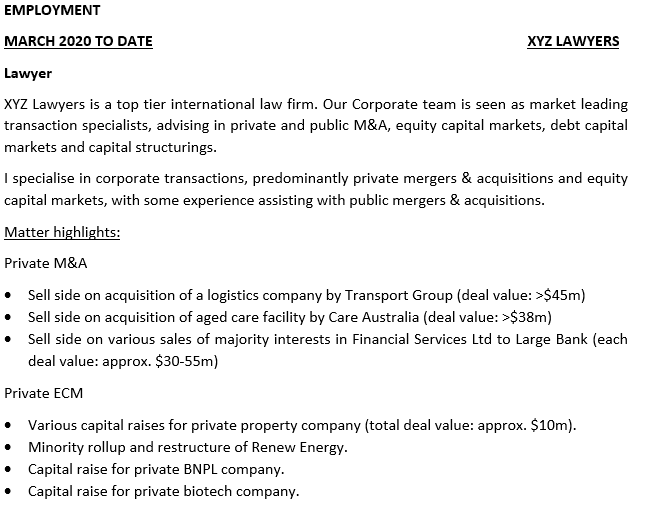How to structure your Associate Lawyer CV
Did you know, on average, people spend just 75 seconds reading your CV? This means you have just over a minute to sell yourself and your strengths to the reader.
This is easier said than done. Three-quarters of CVs are rejected due to bad grammar, spelling, or poor visual layout. So what makes a successful job application?
Here are our top tips for structuring your Associate Lawyer CV, to help you stand out from the crowd, and get noticed by legal recruiters and law firms.
Overview
The objective of your CV is to help you stand out from the crowd and to secure an interview. It should create a positive impression about you in the mind of the interviewer before you meet.
Some advertisements have significant response levels so keeping your CV brief and punchy is important.
It also needs to be professional, business-like and easy to read; focusing on your key achievements and most importantly – aligned to the role you’re applying for.
Structure
We recommend splitting your CV into four sections:
1. Personal information
2. Qualifications
3. Employment history
4. Interests
Personal Information
Include your contact details:
- Full name
- Full address
- Telephone numbers (day/evening/ mobile – as appropriate)
- Email address
If relevant, state whether you are eligible to work or need a work permit.
Always include any language capability and state your honest proficiency.
Qualifications
List your law degree, either a Bachelor of Laws (LLB) or Juris Doctor (JD). You can include the type of bachelor’s degree or higher education you earned, graduation dates and the name of the institution where you earned the degree.
Don’t forget to mention any professional certifications. Employers also value work-related training that results in certifications.
Employment History
- List your most recent role first, clearly including the dates, job title, size, responsibilities, and achievements in that role.
- Focus on your most recent job and allocate more space to it.
- If the company is not well-known, include a brief description of its business.
- Include the month and year of starting and ending each job, with your current position listed as “to date.”
- Account for any gaps in employment and be prepared to explain them in an interview.
- Avoid listing reasons for leaving previous jobs, save that information for the interview.
- Do not exaggerate your experience or accomplishments, honesty is always the best policy.
- Leave salary information off the CV, but be prepared to discuss it with recruiters.
- Use technical or professional jargon only when necessary.
Here’s a good example of how to structure a role (content has been manufactured):

Interests
We like showing interests because it might help create an instant connection with a hiring manager (if they have a similar interest), and they provide some colour to your ‘on-paper’ personality.
Click here to view our CV template
Proofread your resume
Finally, read through your CV before you press send. Read your cv out loud or ask someone else to double-check it, in case any spelling or grammatical errors have slipped through the net.
If you’re after more specific help and guidance on cv preparation, then please reach out to speak to your local Taylor Root consultant. We are always here to help you succeed in your career journey.
Next Chapter: Interview preparation
Related content
- Introduction
- How to structure your associate lawyer CV
- Interview preparation
- The STAR method
- Competency-based interviews
- Top tips for virtual interviews
- The benefits of using a legal recruiter
- How to resign: steps, tips and template
- Why you should think twice before accepting a counter offer



